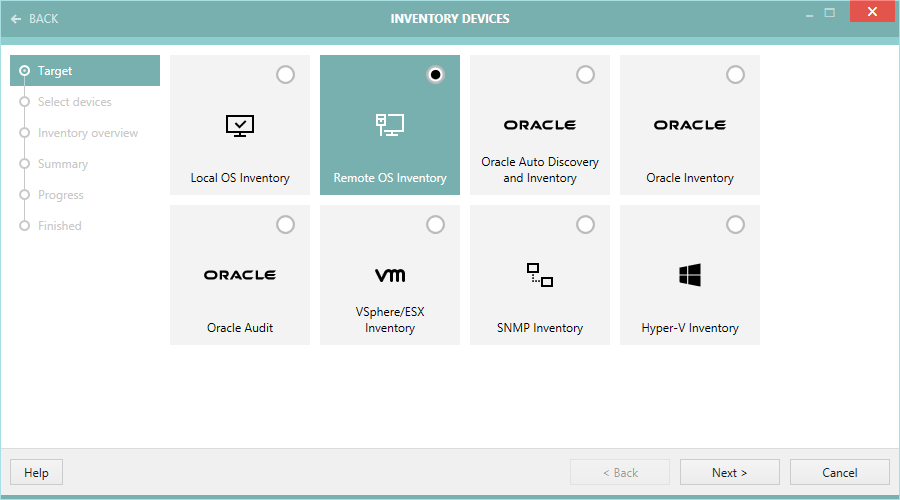The first wizard page asks the user to select the type of inventory he would like to perform.

Based on the selected method, subsequent pages will receive slightly different context. For example, once Remote OS Inventory is selected, the next page shows the list of devices to be scanned. On the other hand, selecting SNMP Inventory shows the list of SNMP connections on the next page, while Local OS Inventory completely hides the second page.
The following options are available:
Local OS Inventory
This runs a local inventory which will give an .ndi file as result. This inventory file includes data regarding the hardware and software of the host. The extend of the inventory can be controlled by adjusting the file wmitrack.ini (query by WMI) or by adding certain registry entries (including the results of special Visual Basic scripts).
This is the only method that can be started without any devices or services configured in the Devices + Services screen.
|
Be aware: Running the local inventory is equivalent of starting ndtrack.exe manually with the following parameters -t machine -o ShowIcon=false -o NetworkSense=false -o Upload=false -o InventoryDirectory="XXX" where XXX is the path to the output folder. |
This option is kept in RayVentory Scan Engine for compatibility reasons. The results of the scan cannot be seen in the Devices view. If you want to perform a scan on the local system and have the results managed by the Devices screen trigger an inventory on a target device with DNS name localhost or IP address of the current host.
Remote OS Inventory
This creates an inventory of a remote machine using either pure Zero-Touch technique or Remote-Execution on the target device. RayVentory Scan Engine automatically chooses the right method for each device, based on various settings, capabilities and previous runs. After selecting remote devices, you will be able to verify which methods get executed on which device by visiting the Inventory Overview page.
Local and remote OS inventories support the following platforms:
•Windows
•Linux*
•HP-UX
•IBM AIX
•OSX
•Solaris
* - conditions apply, support for different Linux distribution may vary.
|
Be aware: There may be certain versions or architectures of platforms that are not supported. |
Oracle Inventory
The actual inventory runs certain queries on an Oracle database in order to retrieve data and hints on license relevant configuration details. In conjunction with the OS inventory of the database host, this data is the source for the reports that help to figure out what kind of Oracle license is needed. If the path to the Oracle's DBFUS script is set, this inventory will also include results from this script. If such an inventory is being imported by a RayVentory Server, this will allow for the comparison on what database features were found to be license relevant by the Oracle Inventory and by the DBFUS script. See Support for Database Feature Usage Script for the requirements that are necessary to enable the DBFUS execution option.
|
Be aware: In order to use this option a Java Runtime Environment (JRE) compatible with at least Java SE 6 must be installed. |
Oracle Auto Discovery and Inventory
Discovers database instances installed on a host and gathers data on enabled options and usage on Oracle database instances.
Oracle Audit
With RayVentory Scan Engine, it is possible to run the Oracle's Review Lite Script on many target databases at once and collect the output files. To use this option, in the setting Review Lite Script path, the path to the copy of the Review Lite Script needs to be set. Furthermore, the path to the SQLplus executable in the local Oracle client installation needs to be set.
vSphere / ESX Inventory
This gathers data regarding host / guest relationships and the host and guest configuration for VMware ESX or vSphere virtual infrastructures. This inventory method requires VMware type credential in the credential store. Addressing the SDK service endpoint of an ESX will retrieve data on all hosts and guests in the cluster.
SNMP Inventory
Gathers basic data on network devices that support the SNMP protocol. This is intended for devices like printers, UPSs, and network equipment that does not expose its Operating Systems or a standardized interface besides SNMP.
Performing Oracle Audit and Discovery
There are two methods are not available in the Wizard, but can be called from other places:
•The inventory method Oracle Audit is not available from the inventory wizard or as an option in the discovery wizard but it is accessible in the context menu of the Oracle list as Audit….
•The discovery / inventory method Oracle Discovery is not available in the inventory wizard but as an option in the Discovery wizard and in the context menu of the Devices list as Oracle Discovery….